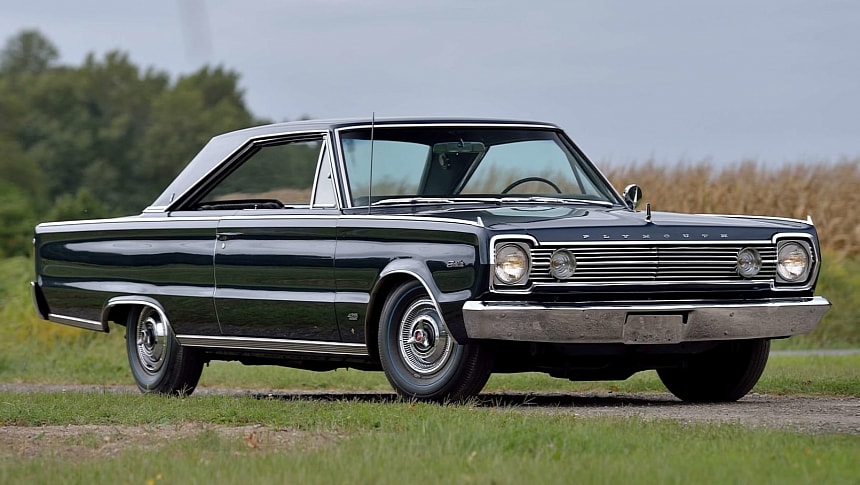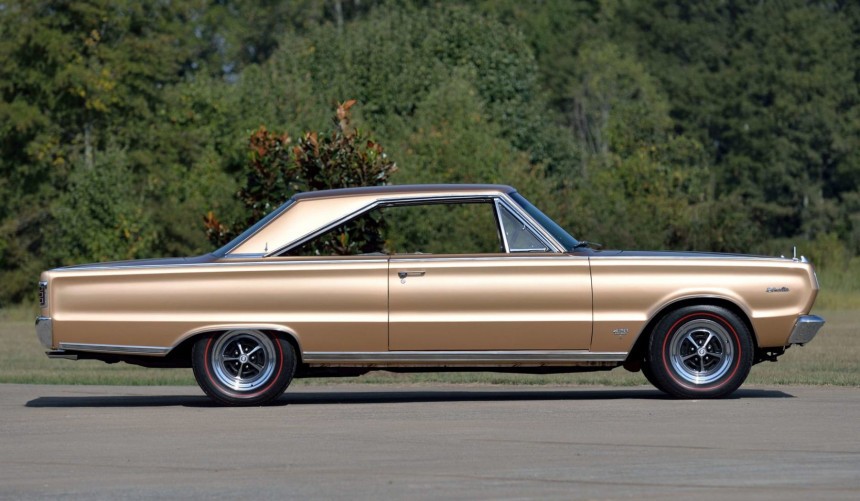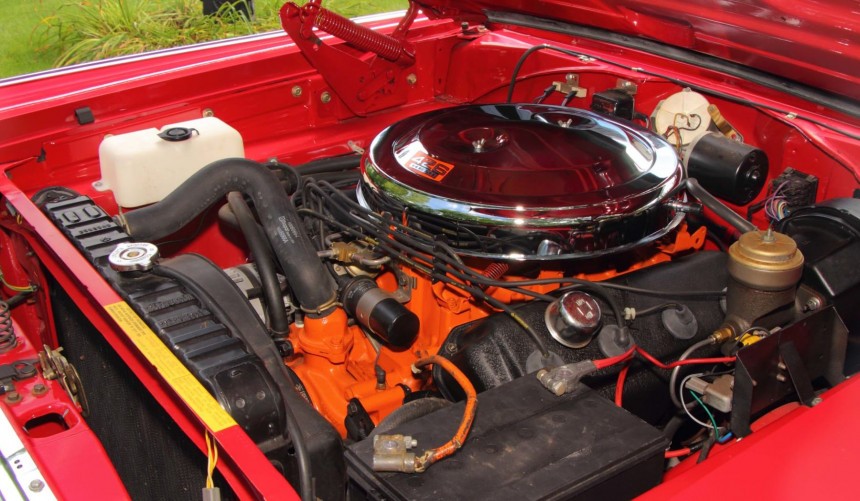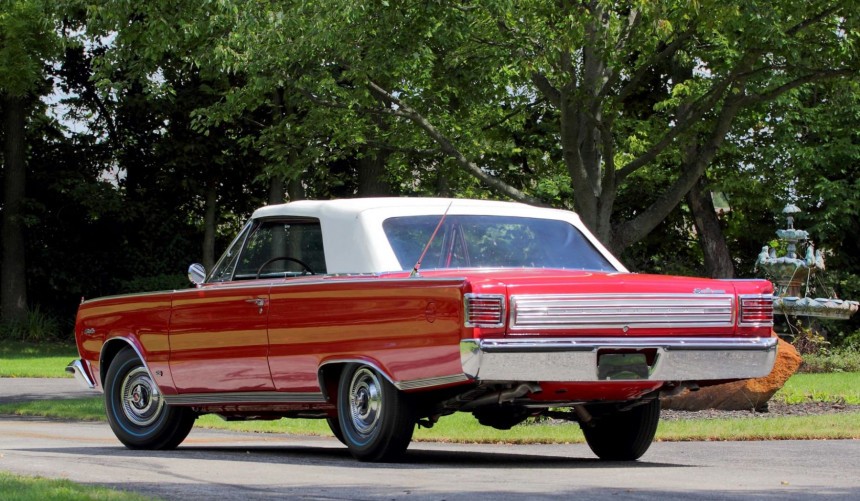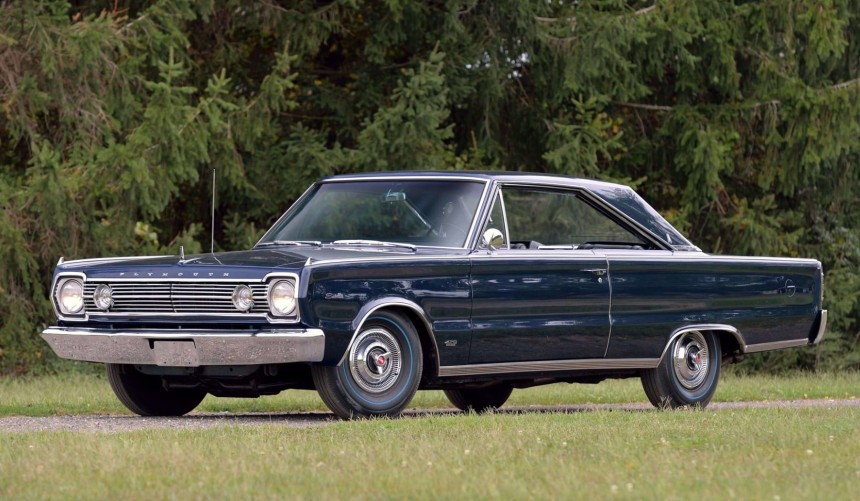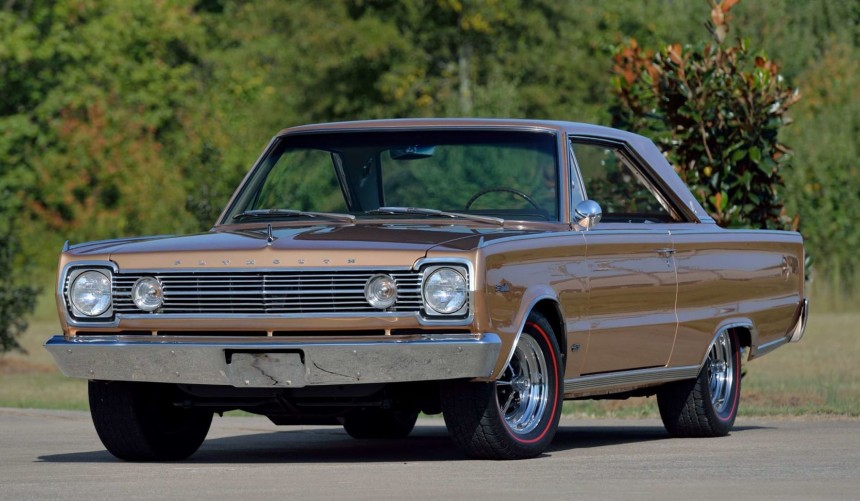Though it looked like an average two-door intermediate, the redesigned Satelite equipped with Chrysler's all-new street HEMI was one of the most potent factory-built performance rides available in 1966, and it continues to be a muscle car legend nearly six decades later.
In 1962, the Plymouth Belvedere was downsized from a full-size model to an intermediate. Three years later, the model was thoroughly redesigned, and its range-topping trim was marketed under the Satellite nameplate.
Only available in the two-door body style in either hardtop or convertible configurations, the Satelite featured more upscale hardware, and, unlike other Belvederes, it was only available with a V8 engine.
In the meantime, Plymouth had dominated the 1964 NASCAR season with its all-new 426 HEMI race engine, but since Chrysler didn't make the powerplant available in high-volume production cars, the competition's governing body banned it for the 1965 season.
Though a year earlier, a few drag strip-oriented Mopars were equipped with a slightly modified 426 race HEMI, Chrysler was now forced to make the engine available in production models, so a full-fledged street version of the famous motor was developed and added to the option list of select 1966 models.
Among those models was the 1966 Satellite, which, like the entire Belvedere line, was mildly restyled once again.
The most distinctive upgrade received by Plymouth's intermediates was a new front grille, but apart from that, it carried over the bulk of the squared-off styling of the 1965 model.
Though it was now available with the high-powered Elephant engine, the Satelite didn't receive any eye-popping visual features such as a decal package, scooped hood, spoiler, or bright colors, like future Mopars.
Instead, the only signs that a Satellite hid a street HEMI under the hood were small 426 badges on the front fenders and a distinct hood ornament.
While the 1966 Satelite looked like an average two-door intermediate, the story was much different when the latest optional engine was stuffed under the hood.
As standard, the model came with a 180-hp, 273-ci (4.5-liter) V8, so it was as unimpressive as it looked.
But, customers could choose from a wide range of optional V8 engines that improved performance.
The first optional motor was a 318-ci (5.2-liter) rated at 230 hp. Next in line was a 265-hp Commando 361 (5.9 liters), followed by a 325-hp Commando 383 (6.2 liters).
Finally, the biggest news for Plymouth enthusiasts was the addition of the 426-ci (7.0-liter) HEMI to the list of optional engines. Heavily based on the 500+ horsepower race version, the street HEMI received a midler cam, a lower compression ratio, and dual four-barrel Carter AFB carbs instead of the large Holley race-bred unit.
Despite these changes, the engine was still rated at 425 (net) hp, a figure that, according to subsequent tests, was lower than the actual output by at least 25 hp.
Checking the HEMI option on the order sheet added around $1,000 to the base price of the Satelite, or nearly $10,000 in today's money.
Thankfully, for that hefty price tag, customers got a bit more than just the NASCAR-derived engine.
To cope with the added weight and power, the Satellite received a heavy-duty suspension system and larger, 11-inch drum brakes normally reserved for the Police cruiser-spec Belvedere.
In 1964, Pontiac kicked off the muscle car craze with its GTO. When equipped with the 389 Tri-Power, the GTO was the quickest factory-built muscle car that money could buy that year.
In 1965, the Tri-Power GTO remained the quickest quarter-mile muscle car in the US, but by 1966, fierce competition meant it was no longer the top dog.
In 1966, Oldsmobile's W-30-equipped 4-4-2 became quarter-mile king. According to a test conducted by Car Craft magazine, the Olds achieved a 13.80-second quarter-mile run while traveling at 105.2 mph (169.3 kph).
Not far behind was the HEMI-powered Satellite, which ran the same distance in 13.80 seconds at 103.8 mph (167 kph), according to a test published by Car and Driver magazine in their April 1966 issue.
Therefore, thanks to the legendary engine, the Satellite went from an average intermediate to a timeless muscle car icon.
One of the most rabid factory sleepers of the 1960s, the 1966 Plymouth Satellite, wasn't as popular as the Tri-Power GTO.
That was mainly because of the engine option's exorbitant price but also because its drum brakes, though larger than standard, did a poor job of stopping the car, which made it hard to tame at high speeds.
That year, Plymouth sold well over 30,000 Satellites, but only 844 left the factory with a 426 street HEMI under the hood.
Today, the 1966 Satellite remains a Mopar icon, but despite being extremely rare, a surviving example in mint shape can be cheaper than subsequent HEMI-powered rides.
Nevertheless, a hardtop still demands well over $50,000, while a convertible, of which only 27 were built, can go for more than twice as much on the rare occasions when one lands under the hammer.
For a virtual tour of a surviving 1966 Satellite HEMI, we recommend watching the YouTube video below by Lou Costabile.
Only available in the two-door body style in either hardtop or convertible configurations, the Satelite featured more upscale hardware, and, unlike other Belvederes, it was only available with a V8 engine.
In the meantime, Plymouth had dominated the 1964 NASCAR season with its all-new 426 HEMI race engine, but since Chrysler didn't make the powerplant available in high-volume production cars, the competition's governing body banned it for the 1965 season.
Though a year earlier, a few drag strip-oriented Mopars were equipped with a slightly modified 426 race HEMI, Chrysler was now forced to make the engine available in production models, so a full-fledged street version of the famous motor was developed and added to the option list of select 1966 models.
A stealthy high-performance intermediate
The most distinctive upgrade received by Plymouth's intermediates was a new front grille, but apart from that, it carried over the bulk of the squared-off styling of the 1965 model.
Though it was now available with the high-powered Elephant engine, the Satelite didn't receive any eye-popping visual features such as a decal package, scooped hood, spoiler, or bright colors, like future Mopars.
Instead, the only signs that a Satellite hid a street HEMI under the hood were small 426 badges on the front fenders and a distinct hood ornament.
The debut of the mighty street HEMI
As standard, the model came with a 180-hp, 273-ci (4.5-liter) V8, so it was as unimpressive as it looked.
But, customers could choose from a wide range of optional V8 engines that improved performance.
The first optional motor was a 318-ci (5.2-liter) rated at 230 hp. Next in line was a 265-hp Commando 361 (5.9 liters), followed by a 325-hp Commando 383 (6.2 liters).
Finally, the biggest news for Plymouth enthusiasts was the addition of the 426-ci (7.0-liter) HEMI to the list of optional engines. Heavily based on the 500+ horsepower race version, the street HEMI received a midler cam, a lower compression ratio, and dual four-barrel Carter AFB carbs instead of the large Holley race-bred unit.
Despite these changes, the engine was still rated at 425 (net) hp, a figure that, according to subsequent tests, was lower than the actual output by at least 25 hp.
Backed up by much-needed chassis upgrades
Thankfully, for that hefty price tag, customers got a bit more than just the NASCAR-derived engine.
To cope with the added weight and power, the Satellite received a heavy-duty suspension system and larger, 11-inch drum brakes normally reserved for the Police cruiser-spec Belvedere.
The second-quickest muscle car over the quarter mile in 1966
In 1965, the Tri-Power GTO remained the quickest quarter-mile muscle car in the US, but by 1966, fierce competition meant it was no longer the top dog.
In 1966, Oldsmobile's W-30-equipped 4-4-2 became quarter-mile king. According to a test conducted by Car Craft magazine, the Olds achieved a 13.80-second quarter-mile run while traveling at 105.2 mph (169.3 kph).
Not far behind was the HEMI-powered Satellite, which ran the same distance in 13.80 seconds at 103.8 mph (167 kph), according to a test published by Car and Driver magazine in their April 1966 issue.
Therefore, thanks to the legendary engine, the Satellite went from an average intermediate to a timeless muscle car icon.
The 1966 Plymouth HEMI Satellite today
That was mainly because of the engine option's exorbitant price but also because its drum brakes, though larger than standard, did a poor job of stopping the car, which made it hard to tame at high speeds.
That year, Plymouth sold well over 30,000 Satellites, but only 844 left the factory with a 426 street HEMI under the hood.
Today, the 1966 Satellite remains a Mopar icon, but despite being extremely rare, a surviving example in mint shape can be cheaper than subsequent HEMI-powered rides.
Nevertheless, a hardtop still demands well over $50,000, while a convertible, of which only 27 were built, can go for more than twice as much on the rare occasions when one lands under the hammer.
For a virtual tour of a surviving 1966 Satellite HEMI, we recommend watching the YouTube video below by Lou Costabile.
